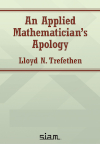- About MAA
- Membership
- MAA Publications
- Periodicals
- Blogs
- MAA Book Series
- MAA Press (an imprint of the AMS)
- MAA Notes
- MAA Reviews
- Mathematical Communication
- Information for Libraries
- Author Resources
- Advertise with MAA
- Meetings
- Competitions
- Programs
- Communities
- MAA Sections
- SIGMAA
- MAA Connect
- Students
- MAA Awards
- Awards Booklets
- Writing Awards
- Teaching Awards
- Service Awards
- Research Awards
- Lecture Awards
- Putnam Competition Individual and Team Winners
- D. E. Shaw Group AMC 8 Awards & Certificates
- Maryam Mirzakhani AMC 10 A Awards & Certificates
- Two Sigma AMC 10 B Awards & Certificates
- Jane Street AMC 12 A Awards & Certificates
- Akamai AMC 12 B Awards & Certificates
- High School Teachers
- News
You are here
An Applied Mathematician's Apology

Publisher:
SIAM
Publication Date:
2022
Number of Pages:
80
Format:
Paperback
Price:
36.00
ISBN:
978-1-611977-18-9
Category:
General
[Reviewed by , on ]
Bill Satzer
05/17/2023
This short book – really a long essay – offers an apologia (in the sense of a defense or explanation) of applied mathematics from the author’s perspective. The title mirrors G. H. Hardy’s A Mathematician’s Apology, perhaps rather ironically since Hardy was no fan of applied mathematics.
The author reflects on his career in applied mathematics – largely in the area of numerical analysis – with biographical details and a fair amount of mathematical content. He describes this book as a serious and personal meditation about mathematics, as Hardy’s was, but one that moves in very different directions. Early in the book, he says that, while he finds his sense of himself as a mathematician and his connections to mathematicians of the past has gotten stronger, he feels a disconnection from the mathematics and mathematicians of the present, and writes in part to explore this.
Trefethen defines numerical analysis as” the study of algorithms for the problems of continuous mathematics”. (This appears to leave the numerical study of problems of discrete mathematics largely to computer science.) He has made substantial contributions to numerical analysis in five areas: approximation theory, complex analysis, real analysis and partial differential equations, functional analysis, and probability and statistical analysis.
Yet he says that none of his work has been influenced by work of pure mathematicians. He also refers to winners of the Fields Medal and notes that, in spite of the way that their efforts are celebrated by the mathematical community as leading-edge contributions, none of their results have influenced him, nor has any of his work apparently influenced them. He finds a remarkable divide between the “theory and proof” people and their “algorithms and computations” counterparts. This, he regards as very unusual given a history where Gauss, Newton and Euler were doing a considerable amount of numerical analysis in combination with their theoretical work.
Trefethen agrees that mathematicians on both ends of the spectrum continue to be productive, but wishes that the degree of separation could be diminished. He finds a “bewilderingly large” fraction of the mathematical community is detached from considerations of physical phenomena in favor of “an extreme attachment to abstraction and technique”.
Bill Satzer (bsatzer@gmail.com), now retired from 3M Company, spent most of his career as a mathematician working in industry on a variety of applications. He did his PhD work in dynamical systems and celestial mechanics.
See the publisher's website.
- Log in to post comments




